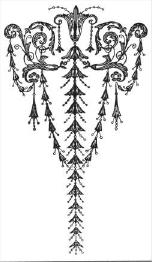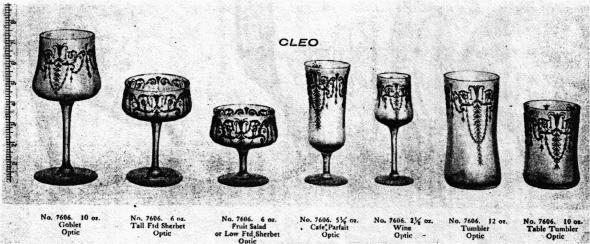Cleo
by Mark Nye
Issue No. 129 - January 1984
It may surprise some readers to learn when the Cleo etching was first used by the Cambridge Glass Company. This should not be the case, however, since the information has been available for some years now.
 In an article written by Jack and Sue Rettig (appearing in the June
1975 issue of the CRYSTAL BALL), an advertisement was reprinted from
the May 22, 1922 issue of China, Glass and Lamps that pictured
the Cleo and Marjorie etchings on #7606 goblets.
Text from the ad, as
reprinted, reads as follows: "Stock patterns in Deep Plate Etched
Glass, work for you every day of the year if you have the correct ones.
Marjorie and Cleo when once started have never failed and they have
many friends."
In an article written by Jack and Sue Rettig (appearing in the June
1975 issue of the CRYSTAL BALL), an advertisement was reprinted from
the May 22, 1922 issue of China, Glass and Lamps that pictured
the Cleo and Marjorie etchings on #7606 goblets.
Text from the ad, as
reprinted, reads as follows: "Stock patterns in Deep Plate Etched
Glass, work for you every day of the year if you have the correct ones.
Marjorie and Cleo when once started have never failed and they have
many friends."
This text sounds as if Cleo was already an established pattern at the time the advertisement was first published. On the other hand, referring to popularity may merely have been an advertising ploy, designed to create a market for a new line. No earlier date has as yet been established for Cleo, but without definitive evidence, it is not possible to say Cleo was new in 1922.
Hazel Marie Weatherman, in her book Colored Glass of the Depression Era 2, published in 1974, reprinted trade journal ads for Cambridge glass dating to 1926 and one of these pictured Cleo. No specific source for these ads was supplied.
The early ads only pictured stemware, as did a "Nearcut" era catalog estimated to have been issued around 1922. This catalog, in addition to stemware, also pictured flat tumblers. (The page showing Cleo was reprinted in the June 1981 issue of the CRYSTAL BALL.) These tumblers and stemware, as well as those in the previously described ads, were all from the #7606 line.
It is yet to be leaned if pieces, other than stemware, were etched Cleo during the years 1922-1928.
The first known dated reference to tableware, dinnerware and luncheon sets with the Cleo etch date to 1929. Quoting from the January 1929 issue of Crockery and Glass Journal: "... Many other charming pieces and decorations are also introduced for the new year. This is especially true in regard to their (Cambridge) dinner service. Outstanding among these treatments is the Cleo etching which deserves a word of special mention. This fascinating design might best be termed an Adam treatment."
In July 1929, four consecutive weekly issues of China, Glass and Lamps featured Cleo on the cover. The July 1 issue pictured the Cleo etched #1095 creamer and sugar and gave availability in colors of Peach-Blo, Emerald, Madeira and Willow Blue. The next week, #3077 stemware was illustrated and the colors were the same, except Madeira was described as "Intriguing new Madeira." The July 15 featured pieces were the #1075 cream soup, #749 two handled bonbon, and the #865 cup and saucer, all from the Decagon line. The last of the four covers showed the Decagon #867 creamer and sugar. Colors, over this short period of time, remained the same. (Webmaster's Note: The four advertisements are shown on a separate page which may take a long time to load on a dial-up connection. CLICK HERE to view that page.)
The October 1929 issue of Crockery and Glass Journal contained a picture of a table set with Cleo etched dinnerware and bore the caption "A table setting featuring the decagon shape, giving some idea of the possibilities of glass dinnerware."
The Welkers, in their Book I of Cambridge Glass Company catalog reprints, reprinted two catalog pages showing Cleo. While no date is given for these pages, several factors indicate they date to 1928-1929. On these pages we find, among other pieces: the #955 62 oz. jug and cover (this is a low jug); the #1095 three-piece creamer and sugar set; and the #813/816/899 three piece set composed of the tall sugar shaker, tall creamer and tray.
The next dated reference for Cleo is the 1930 Cambridge Glass Company catalog reprinted by N.C.C., in which five pages were devoted exclusively to the Cleo etching, along with additional pages showing Cleo together with other items. Two of the five pages were titled "Decagon Dinnerware Plate Etched 'Cleo'" and pictured 17 items. The next two pages pictured #3077 and #3115 stemware, along with a finger bowl from each line, as well as the #3077/10 63 oz. jug and cover. The fifth and last page illustrated four pieces, all from the Decagon line: #984 10" bowl; #971 8½" bowl; #977 11" basket; and the #972 11" plate. (Webmaster's Note: Two Catalog pages showing Cleo on Decagon dinnerware are shown on a separate page which may take a long time to load on a dial-up connection. CLICK HERE to view that page.)
 Further along in the catalog, under a page heading of "Ice Pails,
Candy Boxes and Bridge Sets," we find the #864 candy box and the #851
ice pail. On the next page "Ice Tea and Water Sets," is the #124 68 oz.
jug and cover and the #9403 12 oz. tumbler. No additional references to
Cleo are found in the original 1930 catalog.
Further along in the catalog, under a page heading of "Ice Pails,
Candy Boxes and Bridge Sets," we find the #864 candy box and the #851
ice pail. On the next page "Ice Tea and Water Sets," is the #124 68 oz.
jug and cover and the #9403 12 oz. tumbler. No additional references to
Cleo are found in the original 1930 catalog.
The next illustrations to be found are in the 1931 supplement. Here, under the heading "Business Stimulators," five pieces of Cleo were shown. The Cleo etched ware being promoted in this manner were: #3400/90 two handled, two-compartment relish; #1012 8½" bowl (Decagon); #3400/13 6" four-toed comport; #3077 22 oz. jug and cover; and the #197 6 oz. oil with ground stopper. The latter blank is shown with both the Decagon and Round lines.
The 1931 pages are the last mention of Cleo in the 1930-34 Catalog reprint, but this should not be construed as evidence that Cleo was discontinued after 1931. All that is known at this time is: Cleo was not included in the 1940 or later Cambridge catalogs. Hence, it can be said Cleo was discontinued by January 1, 1940. Exactly when this occurred during the preceding nine years has yet to be determined.
Regarding Cleo in color during the 1930s, the only reference is a note on the General Information page of the 1930 catalog which states: "Practically all items illustrated are made in Crystal, as well as the prevailing transparent colors, such as Amber, Emerald, Peach-Blo, Willow blue and Gold Krystol." Cleo is known in all of these colors and I recall seeing, several years ago, the Decagon #1090 7" tall comport in either Blue I or Blue II, etched Cleo. The latter, however, probably predates 1930.
Cleo is known on #3077 Stemware in all of the previously mentioned 1930 colors and in Peach-Blo with a gold rim band.
As to whether there is a readily discernible difference between Madeira of 1929 and Amber of 1930 remains an open question. I would appreciate hearing from anyone who collects amber Cleo and has two definite shades of amber in their collection.
In addition to Decagon blanks, Cleo was also placed on the round line, as well as the #3400 line. The latter two, however, were used to a much lesser extent than the Decagon line. From the Round dinnerware, the #912 10½" casserole and cover is known in amber, etched Cleo.
In closing, I want to mention two unusual pieces etched Cleo, both in amber. First is a 12" five-compartment tray with mustard jar and lid. This piece has a separate indent in which the mustard jar sits. Second, is a Decagon punch bowl, shaped like the #1085 and #1086 vegetable dishes, but in punch bowl size dimensions. I have been unable to find any reference to a Decagon punch bowl, but I expect it would date to the early 1930s.
